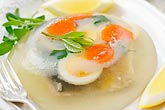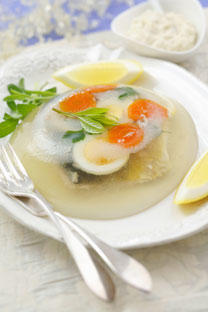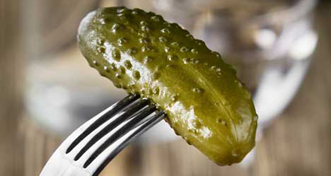Jellied fish – the combination of Russia and French cuisine

Source: Sock Food / Fotodom
 |
| Aspic appeared in Russia thanks to the influence of the French. Source: Sock Food / Fotodom |
Aspic, the cold dish made from fish or meat poured into a cold, rich stock, appeared on the world culinary stage at the beginning of the 19th century thanks to the influence of the French.
However, similar cold starters were being prepared in the lands of Rus long before Peter I (the Great) brought foreign culinary specialists to Russia. When medieval and early modern Russian nobility would entertain guests, they would take the leftovers from the main feast, crush them, mix them with stock and keep them in a cold place. The dish was intended for servants, since it always involved the scraps that remained after the preparation and consumption of a meal.
When French culinary specialists arrived in Russia in the 18th and 19th centuries, they reformed many traditional Russian dishes. These French chefs introduced ways of lightening and coloring the aspic and began to make it with gelatin. The dish, now transparent, became a showcase for the best cuts of meat and fish.
Herbs, spices, roots, vegetables and mushrooms were added to make different flavors and colors of aspic. They were pressed into molds and decorated with lemon slices and vegetables cut into ornamental shapes.
Despite its long presence on the Russian menu, aspic is a bit of an acquired taste. In 2005, U.S. President Barack Obama was served jellied fish during his visit to the Russian city of Saratov - the dish was not to his taste. Obama said the dish gave him a “deeply disturbing” feeling.
Ingredients:
3-4 lbs perch pike (whole fish)
2 medium carrots
2 onions
1.5 oz celery leaf
2 bay leaves
8-10 peppercorns
1 tsp ground black pepper
4 tsp salt
1.5 oz quick dissolving gelatin
10 quail eggs, hard-boiled in slices (optional)
fresh parsley
fresh dill, 1 lemon
How to make it
Aspic can be prepared in advance and kept in a refrigerator for up to seven days. The jelly is poured into molds or salad bowls and can be served in these same dishes.
Different kinds of river fish can be used to prepare the dish, but it is usually made from perch pike, carp or pike.
Perch pike is the best choice because this white fish is low in calories and rich in protein and vitamins.
To start this dish from a whole fish, remove all the gills and innards, debone it, and cut it into equal fillets. Cut off the head and tail, but do not discard them. They should be put in cold water and brought to a boil. Remove the scum and add carrots, onions, parsley, dill, peppercorn, a bay leaf and salt. Continue to cook for 15 minutes, periodically removing the scum.
Remove the tails and the heads from the mixture and drop in the fillets. Cook on medium heat until done. Carefully remove the pieces of fish with a strainer and place on the plate or mold in which you intend to serve the aspic. Strain the stock through two or three layers of gauze or cheesecloth.
The stock should not be boiled for too long, since this could make it cloudy or dark. If your stock does become dark, throwing in a piece of ice after cooking has finished and then bringing the stock again to a boil with clear it up.
Dissolve 1.5 oz of edible gelatin in warm water and mix it with the stock. Allow the mixture to simmer, but do not boil for about 15 minutes.
Put carrots, peas, parsley, or circles of hard-boiled eggs around the fish. Add the stock and store in a cold place.
The dish can be decorated with lemon slices but only after it has set. It is also customary to serve the jellied fish with vegetables, fresh and salted cucumbers, horseradish, vinegar, mayonnaise and olives.
All rights reserved by Rossiyskaya Gazeta.
Subscribe
to our newsletter!
Get the week's best stories straight to your inbox
